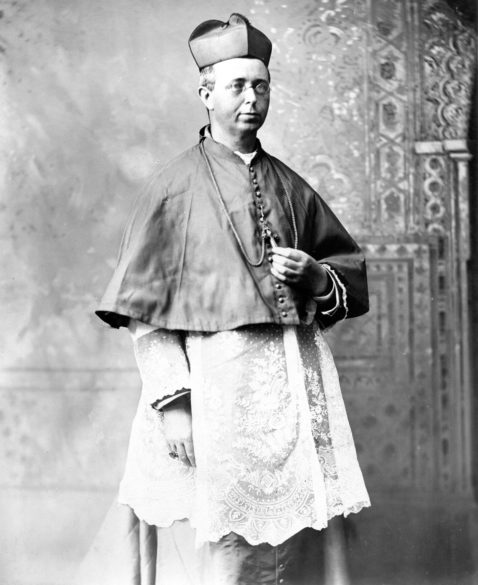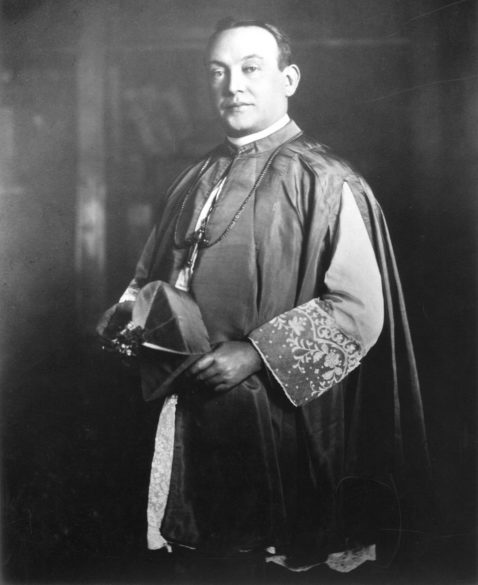From the Archives
By Mary Woodward
JACKSON – A bishop’s life is full of travel around the diocese to visit parishes, schools and missions. This time of year, it involves school masses for the opening of the new academic year. Because of COVID, these celebrations did not occur last August.
Confirmation celebrations have Bishop Joseph Kopacz all over the diocese from one end to the other. These celebrations normally take place between Easter and Pentecost, but due to schedules and once again the pandemic, Confirmation celebrations have been spread out into the summer months.
This weekend Bishop Kopacz will be in Ripley at St. Matthew Mission to confer Confirmation on more than a dozen young people. Ripley is in Tippah County, and I have a special connection to the area because my maternal grandmother’s family is from Tippah County. My great-grandparents are buried in the Pine Hill Cemetery just outside of Ripley on the way to Walnut.

Suffice it to say that our diocese being the largest diocese geographically east of the Mississippi River creates long drives. Tippah County borders Tennessee and is part of the rolling hills section of the state where beautiful views can be found around various bends in the road. Ripley is close to a four-hour drive from Jackson.
Imagine travelling to Ripley on horseback or in a cart from Natchez as was done in the early days of our diocese. This was the life of our bishops back in the day even up into the early 1900s when Bishop Thomas Heslin was making his way around the diocese for Confirmation celebrations.
Let me share a particular instance from Bishop John Gunn’s diary dated June 8, 1912, in which he accounts for an unfortunate incident that led to Bishop Heslin’s ultimate demise. It may give a better appreciation for a bishop’s life on the road.
“Visit to Montpelier. This is a little mission chapel about 13 miles from West Point, without a railroad and with the poorest roads imaginable. On the way out from West Point to Montpelier I heard a story about Bishop Heslin which is worth recording.
“The good Bishop was, like myself, going out to the little chapel to give Confirmation. The best pair of mules in the neighborhood were commandeered to bring the Bishop out. The Bishop’s carriage was a spring wagon and a plank put over the sideboards formed the cushions for the driver and the Bishop.
“The roads were of that peculiar type known in Mississippi as ‘corduroy’ roads. Branches of trees, stumps, logs, etc. are imbedded in the mud roads during the Winter, In the Spring these are covered with dirt and there is a good road until the first rain comes. Then the dirt is washed up and the stumps are very much in evidence, especially when the mules get into a trot.
“It seems that on the past visit of Bishop Heslin, the driver talked all he knew about cotton, lumber, and the country and talked so much that the mules fell asleep. It is thought that Bishop Heslin – if he was not asleep, was at least nodding – and at the moment the driver woke up and commenced to whip the mules into some kind of activity.
“The sudden start caught the Bishop unprepared and he made a double somersault over the spring wagon and fell on the road. The driver was so busy with the mules that he forgot the Bishop and did not know of the mishap for nearly half a mile.
“Then there was the difficulty of turning the pair of mules on the road and a convenient turning spot had to be reached. This delayed the recovery of the Bishop for a considerable time and when the mule driver and his mules found the Bishop – Bishop Heslin was in a dead faint.
“The good Bishop was a big man and a heavy man, and the mule driver was lean and lanky and there was no help in sight or available. There was nothing to do only to take the sideboards from the wagon and form an inclined plane and roll the Bishop up the plane and make him comfortable in the wagon. “He recovered consciousness before he reached West Point.
“It is said that the Bishop never really recovered from the shock and the injury sustained by this fall.
“The driver who brought me out to Montpelier was the same one who had brought Bishop Heslin and he gave me the story as written.”

This incident would have occurred most likely in 1910 because Bishop Heslin died in February 1911.
Bishop Gunn concludes his description of his own arrival and visit in Montpelier thusly: “I arrived at Montpelier for supper. The day was hot, and all the neighbors of the little village were invited to sup with me.
“There was a table spread for all comers on a kind of porch. The neighbors supplied the feed and there was plenty of it. I think that all the flies of the country got notice because they were present like the locusts of Egypt. They were in everything, tasting everything, and lighting everywhere, especially on the bishop’s nose.
“A few girls got branches of trees and used them to keep the flies away. It was all right as long as the girls minded their business but when they forgot the flies and hit the guests there was some embarrassment.
“We had Mass and confirmation in the little chapel, which strange to say was dedicated to St. Patrick and for that reason several parts of it were painted green. We returned to celebrate Sunday.”
More from Bishop Gunn next time…
(Mary Woodward is Chancellor and Archivist for the Diocese of Jackson)
